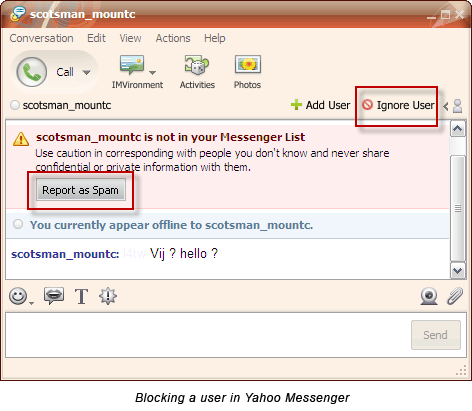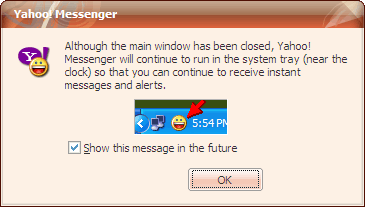- Don’t give out your identity
- Don’t chat with people not on your contact list
- Don’t click on spam links
- Don’t share files with your chat partner
- Don’t let potential hackers reach you
- Don’t Neglect Encryption
- Don’t use an older version of IM – Update
- Don’t download third party plug-ins from unverified sources
- Don’t forget to log-out completely It is an oft repeated habit to click on the [X] button and exit. But this action does not close our IM client completely. Most often, they continue to run in the system tray leaving it ‘open’ for a third person to access it. IMs also have a nasty habit of broadcasting your online presence even if left to run as a background task. Especially in public computers be mindful of logging out and exiting completely. Also, never click on any Remember My Password checkbox during log-in as an added safeguard.
- Don’t forget the value of a good browser, a good firewall and an even better anti-virus
Instant Messenger Hacks: 10 Security Tips to Protect Yourself
Spam, worms, Trojans and viruses are familiar email foes. They are no friends of instant messaging either. So how do we pick our friends from our foes? Perhaps by following what Benjamin Franklin said - Distrust and caution are the parents of security.
Also, by putting these 10 habits in place.
Have you been hacked? Perhaps, you share the concern for a rigorous defense against hackers? Let us know what safety measures you personally use…Source URL: http://sexygirlsthemoom.blogspot.com/2010/11/10-security-tips-to-protect-yourself.html
Visit Sexy Girls for daily updated images of art collection
Most of us will agree that we are paranoid about email security and hack attacks. We should equally be concerned about the other popular connection device we use – the humble instant messenger. It is also open to some of the privacy risks we associate with emails.
Especially in a business environment, unsecured IM installations are creating backdoors for hack attacks. This threat has increased manifold because nearly all IM’s allow for exchange of files, images, songs and even peer to peer sharing of entire folders.Spam, worms, Trojans and viruses are familiar email foes. They are no friends of instant messaging either. So how do we pick our friends from our foes? Perhaps by following what Benjamin Franklin said - Distrust and caution are the parents of security.
Also, by putting these 10 habits in place.
 This is probably what you will be bombarded with first. A link tempts you to click it just for the lark. A lot of these links take you to websites which can install spyware stealthily on your computer. For e.g. Viruses and worms with colorful names such as W32.Yalove or W32/Spybot-MQ are potential threats to Yahoo users. Ignore them.
This is probably what you will be bombarded with first. A link tempts you to click it just for the lark. A lot of these links take you to websites which can install spyware stealthily on your computer. For e.g. Viruses and worms with colorful names such as W32.Yalove or W32/Spybot-MQ are potential threats to Yahoo users. Ignore them.

 For Yahoo Users: Before you get up, delete your Yahoo Messenger profile. It is located by default at C:\Program Files\Yahoo!\Messenger\Profiles.
For Yahoo Users: Before you get up, delete your Yahoo Messenger profile. It is located by default at C:\Program Files\Yahoo!\Messenger\Profiles. Have you been hacked? Perhaps, you share the concern for a rigorous defense against hackers? Let us know what safety measures you personally use…Source URL: http://sexygirlsthemoom.blogspot.com/2010/11/10-security-tips-to-protect-yourself.html
Visit Sexy Girls for daily updated images of art collection






